Some of the links in this post may be affiliate links.
Haworthia cooperi is a very unusual, slow growing succulent that grows in clumps of small rosettes with fleshy translucent leaves. Compared to many other succulents, these are treasured for their ability to grow well without having to be in full sun all day.

Haworthia cooperi a member of the Asphodelaceae plant family and is native to South Africa. It was named after the English botanist Thomas Cooper. It is a highly variable species so there are many different varieties to explore.
One unusual aspect of this plant is that, in the wild, much of the plant grows while buried in sand and only the transparent tips are exposed! The transparent tips allow light to penetrate through so the plant can survive. Indoors, this is not necessary.
Some common names for this plant include Bristle Haworthia, Cooper’s Haworthia, Pussy Foot, and Window Haworthia.
You may also find this plant listed under the synonyms Catevala cooperi. Haworthia cooperi is the accepted species name however.
Table of Contents
HAWORTHIA COOPERI CARE
1. LIGHT
Situate your plant in a bright window, but it does not need to be in full sun all day long. In fact, you should avoid strong, mid-day sun if you can. An eastern facing or western facing window should be perfect for this plant regardless where you live.
If your plant’s leaves become tinged with red or brownish-red, it simply indicates that your plant is receiving too much direct sun.
By all means, this is a plant that should be placed right in front of a window. Conditions that are too dim will weaken your Haworthia cooperi over time and cause it to etiolate (stretch out). It will take time to occur since they are slow growing, so keep this in mind.
With sufficient light, your plant will also flower. Flowers are typically white, sometimes pinkish-white, and the flower stalks can be quite long and appear in Spring or Summer.

If you’re like me and you like to move houseplants outdoors during the warmer summer months, be sure to do so gradually. Regardless whether your plant enjoys direct sun or not, your plant must be placed in complete shade outdoors in order to slowly accustom your plant to higher light.
Read my post on acclimating houseplants to higher light outdoors for more information.
2. TEMPERATURE
Haworthia cooperi is reportedly hardy to about 30F (-1C), but try to keep any minimum temperatures above freezing to be safe. I would not push it though and will recommend sticking with 40F for a minimum night time temperature.
Of course if your plant is indoors, average indoors temperatures will suffice.
3. WATERING
Water thoroughly when you water, and allow excess water to escape the drainage hole(s), and allow the potting mix to dry out completely before watering again.
The plant goes dormant in the summer, so keep watering down to a minimum during this time (just enough to keep the foliage from wrinkling or shriveling).
Be careful when watering to not allow water to get caught in the dense clumps of foliage as this can increase the risk of rotting. You can always gently turn the plant upside-down to drip away any water that has lodged between the leaves.

4. FERTILIZER
This plant is unique, unlike many other succulents, in that it goes dormant during summer and grows during the winter season. It is important not to fertilize during the summer, but you can fertilize dilutely and water a bit more during the other seasons.
In general, a low-Nitrogen fertilizer, or one specifically formulated for cacti and succulents, is good to use. They do not need much fertilizer though. Two applications a year, once in spring and once in autumn, will do.
5. SOIL AND REPOTTING
Sharp drainage is imperative for this plant. A good potting mix consists of 50% succulent/cactus potting mix plus 50% coarse sand or pumice.
I tend to use
Since the plant is pretty slow growing, you can keep it in the same pot for quite a few years. When it is time to repot, you can also consider propagating (see the propagation section in this post). Propagation is best done by dividing offsets.
Keep the pot small, and you may even want to consider using terra cotta pots since they’re wonderful for succulents and will dry out more quickly.
Avoid deep pots since they have a pretty shallow root system.
6. HUMIDITY
Low indoor humidity is perfectly fine for this plant indoors. Avoid locations with high humidity, especially if air circulation is poor. Otherwise, average ambient indoor humidity is sufficient.

7. PROPAGATION
Although you can grow these plants from seed, they are very slow to grow and propagation is best accomplished by vegetative propagation.
Simply take your plant out of its pot, shake off any loose potting mix and gently pull small clumps apart with your hands. Try and make sure that each division has some roots of its own, and simply pot them up separately.
COMMONLY ASKED QUESTIONS & PROBLEMS
Is Haworthia cooperi toxic?
This plant is considered to be non-toxic for pets and humans.
Why are my leaves shriveled?
Normally, there are two reasons why succulent leaves will shrivel. Either your plant has stayed dry for too long, or it has stayed wet for too long and potentially developed root rot. When you notice the shriveling or wrinkling, feel your potting mix. If it is bone dry, go ahead and give it a thorough soaking. If it feels wet, then you need to determine why. Is the plant in too big of a pot? Is the light too low? Was your plant sitting in water? Or perhaps it was a combination of these factors.
Why is my Haworthia cooperi appear stretched out?
Your plant is probably etiolated, meaning that it has stretched out as a result of insufficient light. Although this plant is not among the highest light succulents, they still need to be right in front of a window in order to stay compact.
Why is my cooperi turning brown?
Haworthia cooperi can turn slightly brown if exposed to colder temperatures. Normal green color will return with warmer temperatures. If your leaves are brown and squishy though, this could be a sign of root rot. Leaves can also turn brownish if exposed to too much direct sun.
Why is my plant turning yellow?
If you notice yellow leaves that also feel mushy, it can be a sign that your plant has not dried out enough. Determine the cause of this and correct any conditions causing this.
How often should I water Haworthia cooperi?
Never water anything strictly by a schedule. The correct answer is to water when your plant needs it. Allow the potting mix to completely dry out in between watering and water at that point.
That’s all folks! Do you have a Haworthia cooperi? Comment below. I’d love to hear!







Melinda
Sunday 8th of October 2023
I have a haworthia that made a baby at the end of the flower spike. I left the baby connected to the parent plant, but laid it in some soil. It has been months and it's still not making its own root system. Any advice?
Raffaele
Monday 9th of October 2023
Hi Melinda! Have you been keeping the soil on the dry end, where you inserted the baby plant? This may come as a surprise, but if you've kept it dry, I would recommend to start keeping it fairly moist. Small plants (even succulents) need more water then you'd think, and definitely more water than the parent plant. I assume that your plant is growing in good light and the parent plant looks happy? Try this out and let me know the results!